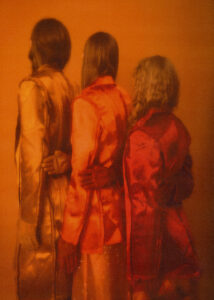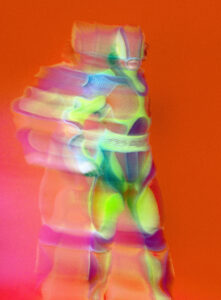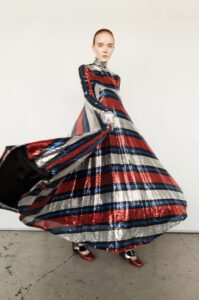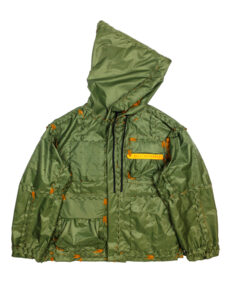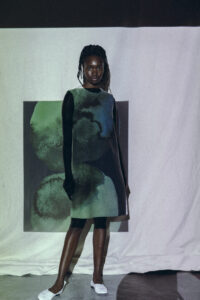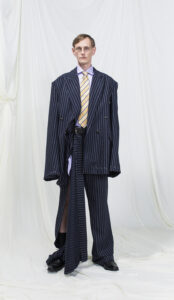Intimacy. 1: the state of being intimate: familiarity 2: something of a personal or private nature 3: the state of having a close, personal relationship or romantic relationship with someone
– Merriam-Webster Dictionary
More than mere fabric, an item of clothing creates a link between the self and others. Fashion is a means for shaping, measuring and communicating the self. In the globalized, networked world, the dressed body and images associated with it have become ever more central means of narration.
Intimacy addresses the new politicization and digitalization currently revolutionizing fashion. The expectation is for fashion to take a stand and change the world. Social sustainability and the principle of non-discrimination have become important values within fashion. Fashion is a form of critical thinking that seeks to promote concepts such as body respect, gender diversity and antiracist practices.
Digitalization has changed fashion design processes, clothes and experiences of fashion. Through technology, clothes have been transformed into data centres that store intimate data and can be connected to other devices, individuals and data networks. Garments can also exist only virtually: in computer games, or on a digital catwalk, for example.
Intimacy explores the intimate relationship between clothing and the body through seven themes, demonstrating the deeply intertwined relationship between fashion and clothing in the 2020s definition of humanity. At the same time, the exhibition can help us to update our understanding of clothing and accessory design. The exhibition features products and works by more than 40 fashion designers, artists or brands with connections to Finland.
The exhibition is a part of the research project Intimacy in Data-Driven Culture (IDA) funded by the Strategic Research Council at the Academy of Finland.
Intimacy of Design
Fashion design is a profession rooted in artisanship and the intimate negotiation between designer and customer. Design emerges from experience-based, tacit knowledge, abstract thinking and hands-on work.
The starting point of the design process is often the body of the designer or another person. The body’s intimate knowledge can be utilized throughout the process: in ideation, conceptualization, drafting, patternmaking and material research, as well as fitting prototypes and model pieces. Some designers prefer to sketch the garment directly onto the body of the model or use the body to examine movement and the flow of materials.
The project starts with an idea, continues with background research, then progresses to the concept of a garment. The background research is used to identify prevailing trends among customer groups, and it is an essential part of the process, providing the basis for design choices. When designing a unique piece of clothing, getting to know the customer is crucial.
The designer’s experience, aesthetic preferences and intuition often play a key role in determining details such as fabric colours or seam placement. Design is also about artistic expression that defies all explanation, and this is what gives fashion its ability to fascinate and allure.
Public Intimacy
An item of clothing is a zone that lies between the self and the world. The assumption exists that a person must always be clothed when meeting others in social situations or in public. Clothing is not only used for practical reasons such as protection against the elements. It is also required because of the prevailing social norms of the community.
Dressing up is a means of self-expression, a public manifestation of who you are and how you would want to be seen by others. This means that dressing up always takes place in relation to, and with awareness of others.
One of the more extensive areas first studied in classical fashion theory was the question of fashion as a representation of class and gender. Nowadays, clothes are also seen as expressions of sexuality, ethnicity, belief system, profession, age, political opinion and personal interests.
Contemporary fashion design intentionally creates communities across national borders, grouping together people with similar ideas into nomad-like groups. Through these, it challenges us to expand our understanding of what kind of bodies belong to the scope of fashion. Contemporary fashion has a critical approach, seeking to accommodate bodies of all sizes and appearances, the diversity of genders and perspectives.
Changes in Intimacy
In the 21st century, fashion has come to play an increasingly important role in art, culture and entertainment. In addition to clothing, different means of representing and contextualizing fashion have become important channels in disseminating information and experiences of fashion. Changes in displaying fashion are most visible in museums and galleries, but the trend is also apparent in commercial and virtual environments.
The change refers to the growing popularity of a conceptual approach to fashion design. Conceptual fashion has its roots in the 1980s and 1990s, when fashion was no longer defined as merely clothes or purchasable goods but was also seen as a medium for critical and creative thought.
As fashion expands to other fields of culture, such as the fine arts, architecture and computer games, new ways of understanding the nature of fashion emerge.
Boundaries of Intimacy
The word intimate can refer to something very close and familiar, or to a close personal relationship with others. An item of clothing can also be seen as a manifestation of this relationship.
The starting point for fashion research used to be to identify how fashion reflects an individual’s relationship with other people. This approach emphasizes fashion in describing humanity, and determines whether it includes exclusively men, women, and children, or also, for example, pet dogs and other non-human beings.
Contemporary fashion research rises to the challenge of defining fashion broadly in its connection to the world. Instead of an anthropocentric approach, the discourse strives to describe the relationship between human beings and other species. A critical question is how to determine the boundaries of humanity and what is characteristic of humans. Humans are seen as unique animals, characterized not only by their ability to use language, but also by their ability to cover and decorate their bodies.
At the same time, fashion has expanded from clothing into space, and can materialize, for example, as installation art. Fashion is closely connected to architecture, painting and sculpture. It is also part of fantasy culture such as film and games.
Shared Intimacy
In his 1967 work The Fashion System (Système de la mode), the French literary theorist Roland Barthes (1915–1980) initiated an area of fashion research that interprets clothes as symbolic texts, arguing that clothes produce meanings and fashion is a communication tool.
Fashion is an excellent example of a contemporary, urban and global communication method. The meanings encoded in clothes can be interpreted in the same way as any other cultural product. The “grammar” of a garment is made up of key concepts that include the volume and texture of the fabric; colours and patterns; size, cut, shape and silhouette of the garment; and the occasion for which it is intended.
Nowadays, the concept of fashion as a form of communication is enhanced: fashion catalogues are displayed on digital channels, and fashion has become mediatized. This means that the media no longer simply disseminate information about fashion; in a fundamental manner, they also shape the ways in which fashion is understood.
Celebrities and social media influencers have become key interpreters of fashion. As a consequence, the personal and the intimate have gained new importance. While fashion has mutated into images and visual language, the media have become a major element of contemporary fashion.
Measured Intimacy
Digitality has become an increasingly important part of fashion, influencing the design and production of clothes as well as the ways in which fashion is distributed and experienced. Wearable technology—clothing, accessories or jewellery that contain some sort of measuring or monitoring device—utilizes data that clothes, or other wearable items collect from their users. An item of clothing can therefore resemble a portal connecting humans to devices and information networks.
The most common applications of wearable technology include functional clothing and accessories such as sports and workwear, or rings and wrist bands that measure stress and activity levels. Many people have become interested in measuring their bodies’ activities in their leisure time, and monitoring and comparing results has become a new dimension of social interaction. Data collected by clothes and other wearables is used to develop these devices still further.
Measuring and monitoring the body has also become part of our working lives. Today, employers can monitor their employees with devices integrated into work wear with more extensive capabilities than access cards. Wearable technology can help to improve workplace security by enabling the monitoring of the work environment and alerting the employer of potential risks.
Measured Intimacy
Digitality has become an increasingly important part of fashion, influencing the design and production of clothes as well as the ways in which fashion is distributed and experienced. Wearable technology—clothing, accessories or jewellery that contain some sort of measuring or monitoring device—utilizes data that clothes, or other wearable items collect from their users. An item of clothing can therefore resemble a portal connecting humans to devices and information networks.
The most common applications of wearable technology include functional clothing and accessories such as sports and workwear, or rings and wrist bands that measure stress and activity levels. Many people have become interested in measuring their bodies’ activities in their leisure time, and monitoring and comparing results has become a new dimension of social interaction. Data collected by clothes and other wearables is used to develop these devices still further.
Measuring and monitoring the body has also become part of our working lives. Today, employers can monitor their employees with devices integrated into work wear with more extensive capabilities than access cards. Wearable technology can help to improve workplace security by enabling the monitoring of the work environment and alerting the employer of potential risks.
Photographs:
1. Emilia Kuurila
Taped on the Skin
2019
2. Leevi Ikäheimo
No Pain, No Glamour
2020
3. Anna Isoniemi
Racing Stripes
2017
4. Maria Korkeila
Fiskars by Maria Korkeila
2020
5. Self-Assembly
Syntax of Clothing
2021
6. Marimekko
The Art of Print and Shape
2021
7. Ville Pölhö
Clone Gone
2021
